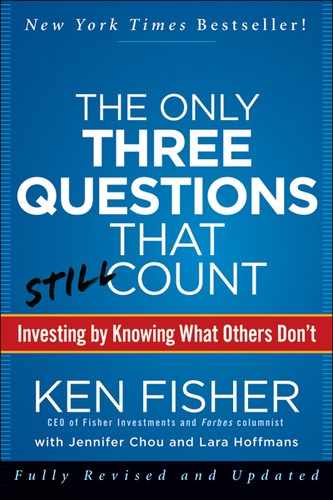APPENDIX D1
I Hate Funds
From my August 20, 2001, Forbes column.
This issue, the mutual fund guide, is a great one in which to tell you this: I hate funds. So should most of you. The average Forbes subscriber (net worth at last count, $2.1 million) is too wealthy for funds. Funds were never meant for you. They were meant for folks with a small pool of money in search of diversification. But at a price. A big one.
For years, I’ve urged a global approach. I won’t retread that now (see, for example, my Nov. 27, 2000, column). But foreign and global funds are expensive.
The average global no-load fund has a 1.8% annual expense ratio—for portfolio management and overhead costs. On top of that are the soft-dollar fees, which are trading commissions, over and above competitive rates, funneled to brokerages for research help they give the fund. Average soft-dollar cost to fund customers: 0.3% of assets annually. It’s a fee that rips you off but is legal. The fund should pay for research from its own revenue.
Then people go haywire and hire a person or service to tell them what funds to own, because there are so many and sorting through them is confusing. The normal fee here is 1% annually. Add these three fees and you could be spending 3% a year to own a global stock portfolio. At that you need real genius to come out ahead. If stocks do 10% in the long term, and if inflation averages 3%, your real return is 7%. A 3% annual fee eats up almost half of that. You wind up with bondlike returns while taking stocklike risks. That’s a sucker’s game.
Then comes performance. Everyone knows the average mutual fund hasn’t kept pace with the market. What they don’t understand is why. It isn’t about stock picking. It’s structural. Here’s why.
Funds tend to be overweighted in small companies, underweighted in large ones. There could be a lot of reasons for this, but a big one is probably just that it’s hard for the portfolio manager to justify a fat money-management fee if he owns only big, obvious stocks like General Electric and ExxonMobil. So during an era like the past decade, when big outperformed small, it was inevitable that funds would underperform the large-cap S&P 500 Index.
You can quantify this disparity. A portfolio has what’s called a weighted average market capitalization. A fund 80% invested in a $10 billion market cap stock and 20% in a $100 billion market cap would have a weighted average market cap of $28 billion. For an index fund tracking the S&P 500, this calculation results in a $110 billion figure. For the average US equity fund, it’s only $24 billion.
It is very restrictive for an actively managed fund to get its weighted average market cap up near $110 billion. There are, at the moment, only 15 companies with market caps above that figure. Funds own many more stocks than that.
And when small stocks beat big? Funds lose again, at least if they trade actively. Small stocks (that is, stocks of companies with market capitalizations below $5 billion) tend to have low share prices and high bid/ask spreads. If a fund goes in and out of a stock quoted at $20 bid, $20.50 offer, it will lose 2.5% to transaction costs. This is as bad as 3% fees.
So I don’t like funds. The actively traded ones will cost you a bundle. The passive index funds are a lot cheaper, and of course an S&P 500 fund will track that index pretty well. But I don’t like those, either. Why? Taxes. There are no tax advantages to funds, only disadvantages.
Fans of funds, including the editors of this magazine, make much of the fact that index funds are tax-efficient. That is, they have not had the habit of forcing out taxable capital gain distributions onto helpless shareholders. But they have been successful at this game in large part because they have been taking in new money over the past decade. Come a time of massive redemptions and the index funds might have to sell some of their low-cost basis shares of stock, making taxable distributions inevitable. Also note that even a tax-efficient fund can’t pass capital losses through to shareholders. If you can use capital losses on your tax return, own shares directly.
Anyone with more than about $350,000, which is most Forbes readers, can do better than a fund by buying stocks. Let me put in a plug for following this column’s advice. It is global. As measured by Forbes annually and after adjusting for phantom 1% brokerage costs, it has beaten the MSCI World, EAFE and S&P 500 for years. It costs you almost nothing. This year? I’ve been cashlike all year. When I turn bullish, I will be recommending stocks. Not funds.
1 Forbes, August 20, 2001. Reprinted by permission of Forbes magazine. © Forbes, 2012.
